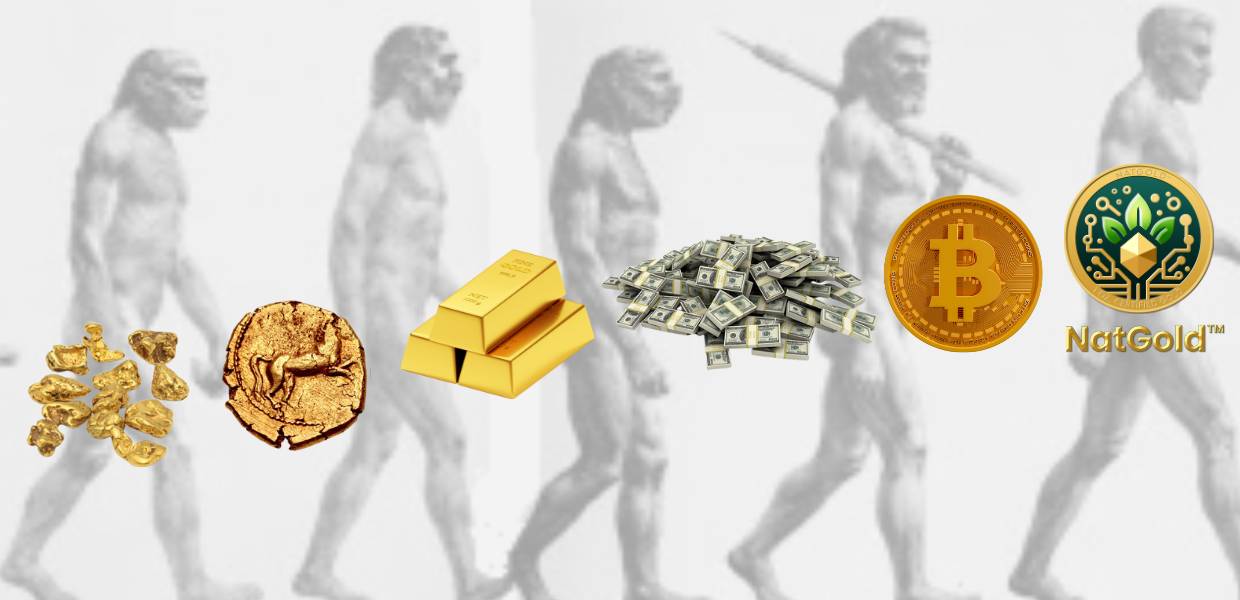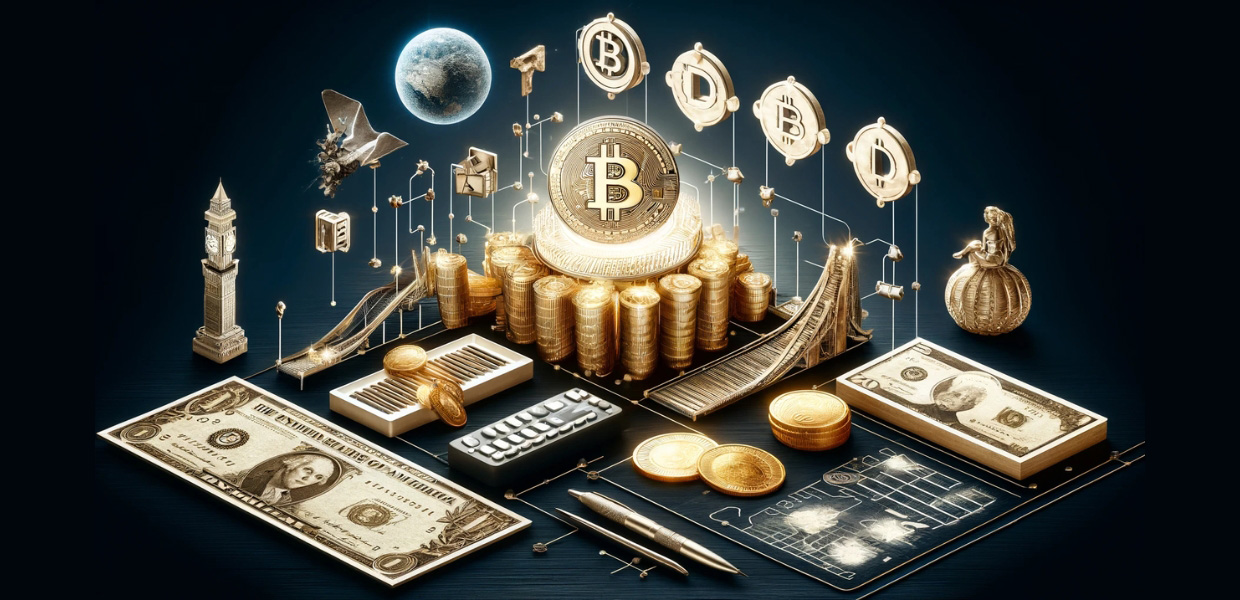Gold’s story as a cornerstone of economic wealth and stability is as ancient as civilization itself. For over 6,000 years, this lustrous metal has not only adorned monarchs and embellished sacred temples but has also served as the ultimate symbol of wealth and a medium of exchange. From the ancient Egyptians to modern financial systems, gold has played a pivotal role in shaping economic practices and policies.
The journey of gold as a universal standard of wealth began in ancient Mesopotamia, where the first transactions using gold as currency were recorded. Civilizations such as the Egyptians, renowned for their immense treasures of gold, used it extensively in trade, jewelry, and as offerings to the gods, underscoring its intrinsic value across cultures and eras.
It was the Lydians, in the 7th century BC, who first introduced gold coins, marking a significant evolution in the use of gold as money. This innovation facilitated trade, bolstered economies, and laid the groundwork for gold as a naturally elected monetary standard. As empires rose and fell, gold remained a constant, reliable measure of wealth and a medium for international trade.
The gold standard, established in the 19th century, further cemented gold’s role in the global economy, linking currencies directly to gold and ensuring a stable, universal value for money. However, this system also limited the flexibility desired by bankers eager to impart a much more elastic “inflationary” monetary policy.
When understanding the dollar, it’s important to know that it used to be completely backed by a gold reserve. Following the lead of Great Britain who dropped the gold standard in 1931, America dropped it two years later. This controversial action served its purpose of preventing people from hoarding gold, which was a common currency prior to 1933. However, it also gave the Federal Reserve more power than ever over the value of the American dollar.
Then just a decade later, the U.S. dollar was anointed the world’s primary reserve currency by virtue of the Bretton Woods Agreement in 1944. At Bretton Woods, central bankers from around the world agreed to fix their individual currencies to the dollar. This means that if you were a central bank anywhere in the world and someone wanted to trade in their local currency for a different one, then you could get that currency from your country’s central bank.
Then the ultimate act to remove any sense of gold backing came on August 15, 1971, when President Richard Nixon announced the suspension of gold convertibility, severing the direct link between gold and the U.S. dollar. This decision marked the end of the gold standard era and the beginning of the US dollar’s worldwide dominance.
Thus, in a period of less than 40 years, an elite banking cartel effectively wiped out 6,000 years of a gold money system and replaced it with a mandated global dollar-based system, which is nothing more than a license to create debt instruments. Every dollar in circulation is debt, backed by the faith one has in the US government, and ultimately its taxpayers, to back up its existence. In contrast with gold which is a debt to no one, the dollar is a debt pledge that went from having the backing of an unelected, naturally selected form of asset backing to a backing completely reliant on faith.
The transition to fiat money, backed not by gold but by government decree, granted central banks unprecedented control over monetary policy. Since departing from the gold standard, the purchasing power of fiat currencies like the U.S. dollar has been significantly eroded. The value of the dollar has been declining steadily since Nixon’s act and in fact, has lost about 95% of its purchasing power.
Global debt, fueled by easy monetary policies and the absence of gold-backed currency constraints, has soared, highlighting concerns over financial stability and sustainability. In reflecting on gold’s legacy, it’s evident that its role transcends mere physical value; it embodies stability, trust, and continuity in an ever-changing world. The end of the gold standard era marked the beginning of an era of unrestrained debt creation, propelled by politicians’ ever-expanding appetite to introduce new spending programs. These programs are music to the ears of their banking allies, who stand to gain from the expansion of debt and the ensuing interest income.
Ironically, the issue was never gold itself. The argument against it was primarily its inelasticity as a form of money, attributed to the lengthy and costly process of mine construction and gold extraction, which made it seemingly inefficient in responding to increased demands for money supply. This perspective fueled much of the rationale behind abandoning the gold standard, especially during the Great Depression.
Today, in this era of widespread access to information and robust debate enabled by the internet, people are becoming increasingly knowledgeable about the dollar and the workings of the global monetary system. This enlightenment has sparked a surge in interest in alternative currencies, propelled by a growing disillusionment with the faith-based dollar.
Ironically, throughout the 6,000-year history of gold’s prominence, numerous items have been experimented with as monetary substitutes, from beads and seashells to tulips. Similarly, the current trend in digital assets has seen a plethora of experiments, from assets backed by algorithms to avocados. Yet, the natural solution has always been right before us, awaiting its revival. The convergence of an ESG-conscious approach through the monetization of certified in-ground gold resources to create NatGold promises a resurgence of gold as the quintessential form of natural money, poised to advance human progress and offer everyone a reliable and stable store of value.
Furthermore, NatGold provides a far more elastic response to the needs of the money supply than extracted gold. For starters, the supply of NatGold vastly exceeds that of certified gold resources that can be economically extracted. Moreover, the process of digital mining is nearly instantaneous, unlike the physical extraction process, which demands significant capital investment and time.
As the world seeks a viable alternative to the faltering debt-based, fiat money system, with the US dollar at its core, the International NatGold Council is determined to bring NatGold into the global dialogue. We are confident that gold, in the form of NatGold, will reclaim its rightful place as the foundational element of our monetary system.
Gold’s story as a cornerstone of economic wealth and stability is as ancient as civilization itself. For over 6,000 years, this lustrous metal has not only adorned monarchs and embellished sacred temples but has also served as the ultimate symbol of wealth and a medium of exchange. From the ancient Egyptians to modern financial systems, gold has played a pivotal role in shaping economic practices and policies.
The journey of gold as a universal standard of wealth began in ancient Mesopotamia, where the first transactions using gold as currency were recorded. Civilizations such as the Egyptians, renowned for their immense treasures of gold, used it extensively in trade, jewelry, and as offerings to the gods, underscoring its intrinsic value across cultures and eras.
It was the Lydians, in the 7th century BC, who first introduced gold coins, marking a significant evolution in the use of gold as money. This innovation facilitated trade, bolstered economies, and laid the groundwork for gold as a naturally elected monetary standard. As empires rose and fell, gold remained a constant, reliable measure of wealth and a medium for international trade.
The gold standard, established in the 19th century, further cemented gold’s role in the global economy, linking currencies directly to gold and ensuring a stable, universal value for money. However, this system also limited the flexibility desired by bankers eager to impart a much more elastic “inflationary” monetary policy.
When understanding the dollar, it’s important to know that it used to be completely backed by a gold reserve. Following the lead of Great Britain who dropped the gold standard in 1931, America dropped it two years later. This controversial action served its purpose of preventing people from hoarding gold, which was a common currency prior to 1933. However, it also gave the Federal Reserve more power than ever over the value of the American dollar.
Then just a decade later, the U.S. dollar was anointed the world’s primary reserve currency by virtue of the Bretton Woods Agreement in 1944. At Bretton Woods, central bankers from around the world agreed to fix their individual currencies to the dollar. This means that if you were a central bank anywhere in the world and someone wanted to trade in their local currency for a different one, then you could get that currency from your country’s central bank.
Then the ultimate act to remove any sense of gold backing came on August 15, 1971, when President Richard Nixon announced the suspension of gold convertibility, severing the direct link between gold and the U.S. dollar. This decision marked the end of the gold standard era and the beginning of the US dollar’s worldwide dominance.
Thus, in a period of less than 40 years, an elite banking cartel effectively wiped out 6,000 years of a gold money system and replaced it with a mandated global dollar-based system, which is nothing more than a license to create debt instruments. Every dollar in circulation is debt, backed by the faith one has in the US government, and ultimately its taxpayers, to back up its existence. In contrast with gold which is a debt to no one, the dollar is a debt pledge that went from having the backing of an unelected, naturally selected form of asset backing to a backing completely reliant on faith.
The transition to fiat money, backed not by gold but by government decree, granted central banks unprecedented control over monetary policy. Since departing from the gold standard, the purchasing power of fiat currencies like the U.S. dollar has been significantly eroded. The value of the dollar has been declining steadily since Nixon’s act and in fact, has lost about 95% of its purchasing power.
Global debt, fueled by easy monetary policies and the absence of gold-backed currency constraints, has soared, highlighting concerns over financial stability and sustainability. In reflecting on gold’s legacy, it’s evident that its role transcends mere physical value; it embodies stability, trust, and continuity in an ever-changing world. The end of the gold standard era marked the beginning of an era of unrestrained debt creation, propelled by politicians’ ever-expanding appetite to introduce new spending programs. These programs are music to the ears of their banking allies, who stand to gain from the expansion of debt and the ensuing interest income.
Ironically, the issue was never gold itself. The argument against it was primarily its inelasticity as a form of money, attributed to the lengthy and costly process of mine construction and gold extraction, which made it seemingly inefficient in responding to increased demands for money supply. This perspective fueled much of the rationale behind abandoning the gold standard, especially during the Great Depression.
Today, in this era of widespread access to information and robust debate enabled by the internet, people are becoming increasingly knowledgeable about the dollar and the workings of the global monetary system. This enlightenment has sparked a surge in interest in alternative currencies, propelled by a growing disillusionment with the faith-based dollar.
Ironically, throughout the 6,000-year history of gold’s prominence, numerous items have been experimented with as monetary substitutes, from beads and seashells to tulips. Similarly, the current trend in digital assets has seen a plethora of experiments, from assets backed by algorithms to avocados. Yet, the natural solution has always been right before us, awaiting its revival. The convergence of an ESG-conscious approach through the monetization of certified in-ground gold resources to create NatGold promises a resurgence of gold as the quintessential form of natural money, poised to advance human progress and offer everyone a reliable and stable store of value.
Furthermore, NatGold provides a far more elastic response to the needs of the money supply than extracted gold. For starters, the supply of NatGold vastly exceeds that of certified gold resources that can be economically extracted. Moreover, the process of digital mining is nearly instantaneous, unlike the physical extraction process, which demands significant capital investment and time.
As the world seeks a viable alternative to the faltering debt-based, fiat money system, with the US dollar at its core, the International NatGold Council is determined to bring NatGold into the global dialogue. We are confident that gold, in the form of NatGold, will reclaim its rightful place as the foundational element of our monetary system.
Enjoyed this article? Subscribe to NatGold News & Insights for the latest staff updates, expert analysis, exclusive interviews, and updates whenever NatGold is making headlines — all delivered straight to your inbox!
Share This Story!
More Staff Insights
In the verdant landscapes of Micronesia, on the Ya...
Gold mining, while a lucrative and age-old industr...
Cryptocurrencies, especially Bitcoin, have ignited...





